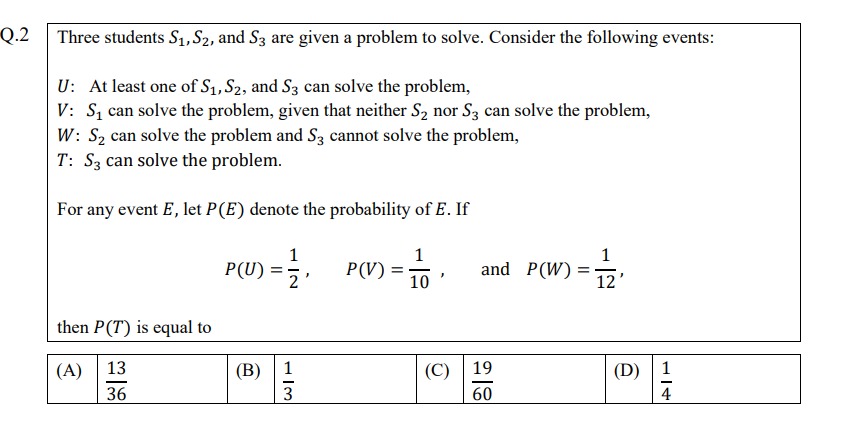Question
Question: Three students $S_1, S_2$, and $S_3$ are given a problem to solve. Consider the following events: $...
Three students S1,S2, and S3 are given a problem to solve. Consider the following events:
U: At least one of S1,S2, and S3 can solve the problem,
V: S1 can solve the problem, given that neither S2 nor S3 can solve the problem,
W: S2 can solve the problem and S3 cannot solve the problem,
T: S3 can solve the problem.
For any event E, let P(E) denote the probability of E. If
P(U)=21, P(V)=101, and P(W)=121,
then P(T) is equal to

3613
31
6019
41
3613
Solution
Let S1,S2,S3 be the events that students S1,S2,S3 can solve the problem, respectively. Let Sic be the event that student Si cannot solve the problem.
The event U is "At least one of S1,S2, and S3 can solve the problem". This is S1∪S2∪S3. We are given P(U)=P(S1∪S2∪S3)=1/2. The complement of U, Uc, is the event that none of them can solve the problem, which is S1c∩S2c∩S3c. P(Uc)=P(S1c∩S2c∩S3c)=1−P(U)=1−1/2=1/2.
The event V is "S1 can solve the problem, given that neither S2 nor S3 can solve the problem". This is the conditional probability P(S1∣S2c∩S3c). We are given P(V)=P(S1∣S2c∩S3c)=1/10. Using the definition of conditional probability, P(S1∣S2c∩S3c)=P(S2c∩S3c)P(S1∩S2c∩S3c). So, P(S2c∩S3c)P(S1∩S2c∩S3c)=1/10.
Consider the event S2c∩S3c. This event can be partitioned into two disjoint events based on whether S1 solves the problem or not: (S1∩S2c∩S3c) and (S1c∩S2c∩S3c). So, P(S2c∩S3c)=P(S1∩S2c∩S3c)+P(S1c∩S2c∩S3c). Let a=P(S1∩S2c∩S3c). We know P(S1c∩S2c∩S3c)=1/2. So, P(S2c∩S3c)=a+1/2. Substitute this into the equation from P(V): a+1/2a=1/10. 10a=a+1/2 9a=1/2 a=1/18. So, P(S1∩S2c∩S3c)=1/18. And P(S2c∩S3c)=1/18+1/2=1/18+9/18=10/18=5/9.
The event W is "S2 can solve the problem and S3 cannot solve the problem". This is S2∩S3c. We are given P(W)=P(S2∩S3c)=1/12.
The event T is "S3 can solve the problem". This is S3. We want to find P(T)=P(S3). The complement of T is Tc=S3c. We have P(S3)=1−P(S3c).
Consider the event S3c. This event can be partitioned based on the outcomes of S1 and S2: S3c=(S1∩S2∩S3c)∪(S1∩S2c∩S3c)∪(S1c∩S2∩S3c)∪(S1c∩S2c∩S3c). These four events are mutually exclusive. P(S3c)=P(S1∩S2∩S3c)+P(S1∩S2c∩S3c)+P(S1c∩S2∩S3c)+P(S1c∩S2c∩S3c).
We know: P(S1∩S2c∩S3c)=1/18. P(S1c∩S2c∩S3c)=1/2.
Consider the event S2∩S3c. This event is the union of two disjoint events: S2∩S3c=(S1∩S2∩S3c)∪(S1c∩S2∩S3c). So, P(S2∩S3c)=P(S1∩S2∩S3c)+P(S1c∩S2∩S3c). We are given P(S2∩S3c)=1/12. So, P(S1∩S2∩S3c)+P(S1c∩S2∩S3c)=1/12.
Now substitute the known probabilities into the expression for P(S3c): P(S3c)=[P(S1∩S2∩S3c)+P(S1c∩S2∩S3c)]+P(S1∩S2c∩S3c)+P(S1c∩S2c∩S3c). P(S3c)=P(S2∩S3c)+P(S1∩S2c∩S3c)+P(S1c∩S2c∩S3c). P(S3c)=1/12+1/18+1/2.
To sum these fractions, find a common denominator, which is 36. 1/12=3/36. 1/18=2/36. 1/2=18/36. P(S3c)=3/36+2/36+18/36=(3+2+18)/36=23/36.
Finally, P(T)=P(S3)=1−P(S3c)=1−23/36=(36−23)/36=13/36.
This matches option (A). The solution did not require assuming independence of the events S1,S2,S3.
